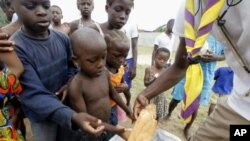Agricultural researchers from five African countries and Australia met in Kenya's capital recently to discuss how to improve food security in Eastern and Southern Africa. Under a four-year joint program called SIMLESA, researchers aim to increase the quality and quantity of maize and legume crops through the use of new or improved technologies. This, in turn, is expected to raise farmers' incomes and make more food available in local and international markets.
The Food and Agriculture Organization says Sub-Saharan Africa has the highest incidence of hunger, with some one-third of the population estimated to be undernourished.
Maize is a crucial staple crop for most Sub-Saharan Africans, especially the poor. Yet the continent imports 28 percent of its required maize from countries outside of Africa.
Helping farmers increase the quantity and quality of their maize and other food legumes is a key goal of the four-year program SIMLESA, or Sustainable Intensification of Maize-Legume, cropping systems for food security in Eastern and Southern Africa.
Funded by the Australian government, scientists from Ethiopia, Kenya, Malawi, Mozambique and Tanzania are experimenting with a range of technologies to boost yields in the face of droughts, diseases, and pests in their countries.
Dr. Bekele Shiferaw, SIMLESA's chair and a director at the International Maize and Wheat Improvement Center, says key among them is the development and distribution of high-yielding, drought-tolerant maize. These varieties are designed to withstand fluctuations in water supply.
"We are also developing another type of maize, which is called quality protein maize for Africa," said Shiferaw. "It is using a conventional breeding approach enhancing the nutritional value of maize by bringing in genes which provide higher levels of lysine and tryptophan, which are essential amino acids required for children, mothers, and so forth."
Dr. John Dixon, regional coordinator for Africa at the Australian Center for International Agricultural Research, says breeding crops to withstand drought, diseases and pests, and increase nutritional content and yields, is an important part of a food security strategy.
He says scientists can do this by examining genetic markers in plants.
"Genetic markers are like [what] doctors use now in medicine to identify people who may be at risk of a certain disease," he said. "We can do the same with plants and we can use genetic markers to identify which plants might be very efficient in using water, or which plants might be resistant to a particular plant disease. By using these genetic markers, we can reduce the numbers of years it takes breeders to develop new and better cultivars of crops."
Dr. Dixon says this is not to be confused with genetically-modified crops, which introduces foreign genetic material into an existing plant.
Once scientists identify a plant's strength, they can then recommend that crop to farmers and work with seed companies to make the seeds available to farmers. In each country, researchers are partnering with local agencies and farmers to develop and implement the various technologies.
Researchers are also looking at how crops grown at the same time or in a particular sequence affect one another.
Dr. Marianne Banziger, a deputy director general at the International Maize and Wheat Improvement Center, explains how legume crops help maize to grow.
"There is a good interaction between the legume and the maize because the legume puts the nitrogen fertilizer - one type of fertilizer - into the ground for the maize to use," she said."So, if you grow maize after legumes, if you grow maize after groundnuts, if you grow maize after other kinds of legumes, the [maize] yield tends to go up."
Legumes such as pigeon pea, common bean, soybean, and groundnuts form another important cornerstone of SIMLESA's food security strategy. Rich in protein, iron and vitamins, researchers are urging maize farmers to grow more of these crops as sources of food security and cash for the family.
SIMLESA chair Dr. Bekele Shiferaw says this is where Africa has tremendous potential.
"South Asia is a major importing continent for legumes produced in Africa. Pigeon peas and chick peas, which are grown by small-holder farmers in this region, are exported," said Shiferaw. "Many small-holder farmers organize into cooperatives. They export chick peas to India, to Bangladesh, to Pakistan, so there is a very well-developed export market for these legumes."
For instance, Ethiopia is one of sub-Saharan Africa's largest chick-pea producers, exporting up to 60 tons of chick peas every year to Asian countries. Kenya, Malawi, and Tanzania also export pigeon peas to these markets.
SIMLESA researchers also aim to introduce to farmers agricultural techniques that conserve the environment.
Chief among them is so-called "minimum" or "zero tillage," techniques, where seeds are planted with minimal soil disturbance or without plowing. Such techniques are used widely in industrialized countries. The undisturbed soil, often covered by crop residues, retains moisture, reduces soil erosion, and cuts down on labor.
SIMLESA chair Dr. Shiferaw says what is ideal for most small-scale farmers is a "jab planter," a hoe or stick that puts seed directly into the ground.
"We are developing different types of small-scale equipment using local manufacturers to actually integrate the conservation agriculture system into what has traditionally been the plow culture in Easter and Southern Africa," said Shiferaw.
Through these and other technologies, SIMLESA researchers aim to increase small-scale farmers' food production by 30 percent within the next decade.
The program is targeting some 500,000 farms in the five countries, which is expected to increase food security for some three million people in Eastern and Southern Africa.
Researchers Developing New Techniques to Improve Food Security In Africa









